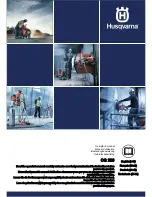
•
4
•
b.
Do not use the power tool if the switch does not turn it on and off.
Any power tool that cannot be controlled with the switch is dangerous and
must be repaired.
c.
Disconnect the plug from the power source and/or the battery pack
from the power tool before making any adjustments, changing
accessories, or storing power tools.
Such preventive safety measures
reduce the risk of starting the power tool accidentally.
d.
Store idle power tools out of the reach of children and do not allow
persons unfamiliar with the power tool or these instructions to
operate the power tool.
Power tools are dangerous in the hands of
untrained users.
e.
Maintain power tools. Check for misalignment or binding of moving
parts, breakage of parts and any other condition that may affect the
power tool’s operation. If damaged, have the power tool repaired
before use.
Many accidents are caused by poorly maintained power
tools.
f.
Keep cutting tools sharp and clean.
Properly maintained cutting tools
with sharp cutting edges are less likely to bind and are easier to control.
g.
Use the power tool, accessories and tool bits etc. in accordance with
these instructions, taking into account the working conditions and
the work to be performed.
Use of the power tool for operations different
from those intended could result in a hazardous situation.
5.
Battery tool use and care
a.
Recharge only with the charger specified by the manufacturer.
A charger that is suitable for one type of battery pack may create a risk of
fire when used with another battery pack.
b.
Use power tools only with specifically designated battery packs.
Use of any other battery packs may create a risk of injury and fire.
c.
When battery pack is not in use, keep it away from other metal
objects, like paper clips, coins, keys, nails, screws or other small
metal objects that can make a connection from one terminal to
another.
Shorting the battery terminals together may cause burns or a
fire.
d.
Under abusive conditions, liquid may be ejected from the battery;
avoid contact. If contact accidentally occurs, flush with water. If
liquid contacts eyes, additionally seek medical help.
Liquid ejected
from the battery may cause irritation or burns.
6.
Service
a.
Have your power tool serviced by a qualified repair person using
only identical replacement parts.
This will ensure that the safety of the
power tool is maintained.
Summary of Contents for BCL32DG1
Page 101: ...101 BCL32DG1 1 1 2...
Page 102: ...102 3...
Page 103: ...103 4...
Page 104: ...104 5 6...
Page 105: ...105 2 1 2 3 4 5 3 1 2 3 4 5 6 7...
Page 106: ...106 8 9 10 4 1 0 C 32 F 40 C 104 F 2 3 4 5 6 7 8 9 50 C 122 F 10 11 12 13 3 6 40 80...
Page 107: ...107 14 25 C 77 F 15 16 5 II ft lb...
Page 108: ...108 6 1 3 2 1 2 3 7 1 2 3 4 1 2 3 4 5 6 7 8 9...
Page 110: ...110 8 1 2 3 4 1 2 5 1 2...
Page 151: ...151 BCL32DG1 1 1 2...
Page 152: ...152 RCD RCD 3...
Page 153: ...153 4...
Page 154: ...154 5 6 2 1 2...
Page 155: ...155 3 4 5 3 1 2 3 4 5 6 7 8 9...
Page 157: ...157 16 5 II a c d c W Watt V Volt Hz Hertz min kg mm kg cm ft lb 6 1 3 2 1 LED 2 3...
Page 158: ...158 7 1 2 3 4 1 2 3 4 5 6 7 8 9 LED 80 100...
Page 160: ...160 2 3 4 1 2 5 1 2...
Page 162: ......





































